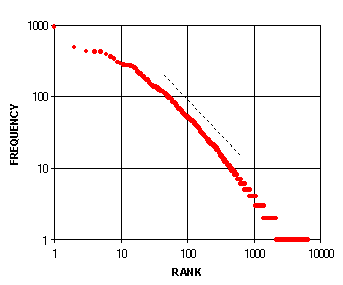当前你的浏览器版本过低,网站已在兼容模式下运行,兼容模式仅提供最小功能支持,网站样式可能显示不正常。
请尽快升级浏览器以体验网站在线编辑、在线运行等功能。
2550:Zipf's Law
题目描述
 Harvard linguistics professor George Kingsley Zipf (1902-1950) observed that the frequency of the kth most common word in a text is roughly proportional to 1/k. He justified his observations in a book titled Human behavior and the principle of least effort published in 1949. While Zipf's rationale has largely been discredited, the principle still holds, and others have afforded it a more sound mathematical basis.
Harvard linguistics professor George Kingsley Zipf (1902-1950) observed that the frequency of the kth most common word in a text is roughly proportional to 1/k. He justified his observations in a book titled Human behavior and the principle of least effort published in 1949. While Zipf's rationale has largely been discredited, the principle still holds, and others have afforded it a more sound mathematical basis.
You are to find all the words occurring n times in an English text. A word is a sequence of letters. Words are separated by non-letters. Capitalization should be ignored. A word can be of any length that an English word can be.
输入解释
Input consists of several test cases. The first line of each case contains a single positive integer n. Several lines of text follow which will contain no more than 10000 words. The text for each case is terminated by a single line containing EndOfText. EndOfText does not appear elsewhere in the input and is not considered a word.
输出解释
For each test case, output the words which occur n times in the input text, one word per line, lower case, in alphabetical order. If there are no such words in input, output the following line:
There is no such word.
Leave a blank line between cases.
There is no such word.
Leave a blank line between cases.
输入样例
2
In practice, the difference between theory and practice is always
greater than the difference between theory and practice in theory.
- Anonymous
Man will occasionally stumble over the truth, but most of the
time he will pick himself up and continue on.
- W. S. L. Churchill
EndOfText
输出样例
between difference in will
最后修改于 2020-10-29T06:35:33+00:00 由爬虫自动更新
共提交 0 次
通过率 --%
| 时间上限 | 内存上限 |
| 3000 | 65536 |
登陆或注册以提交代码